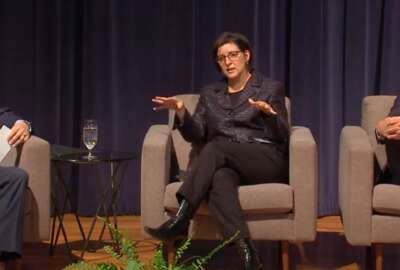Academic challenge nets knowledge and possible future employees for the FDIC
A team of four students at a Virginia university won the challenge competition put on by the Federal Deposit Insurance Corporation.
Best listening experience is on Chrome, Firefox or Safari. Subscribe to Federal Drive’s daily audio interviews on Apple Podcasts or PodcastOne.
A team of four students at a Virginia university won a challenge competition put on by the Federal Deposit Insurance Corporation. Hosted by FDIC’s Center for Financial Research, this year’s challenge asks students to examine how the pandemic affected banking. Here with details, the FDIC’s senior economic researcher Jonathan Pogach joined the Federal Drive with Tom Temin.
Interview transcript:
Tom Temin: Mr. Pogach, good to have you on.
Jonathan Pogach: Nice to be here with you.
Tom Temin: What was the purpose of the competition in terms of what the FDIC was hoping to get out of this?
Jonathan Pogach: The academic challenge is an opportunity for the FDIC and the CFR Center for Financial Research, to engage with the academic community at large, and with students in particular, to help encourage them to think through the complex kinds of questions that we, as the FDIC, as a banking regulator have to deal with ourselves. It’s a great opportunity for us to also promote careers at the FDIC and in economics in similar fields to young promising students.
Tom Temin: Yeah, because when you combine economics and banking, that’s not a vastly subscribed to area of academic work for a lot of students. And yet, you and I know how fascinating it is, but this is a way, I guess, to get those people to understand, yeah, this is a great place, right?
Jonathan Pogach: It’s a way for them to both understand the great things that we do at the FDIC, but also just getting them to think about these topics, which, frankly, without competitions like this, or a particularly motivating professor or things that might not be on their radar, and there’s just a lot of interesting questions and challenges for them to explore.
Tom Temin: And do they win any kind of prize or what happens to the team? We’ll get into the details, but the team that won, what do they win?
Jonathan Pogach: Really it’s bragging rights. I think it’s a great opportunity for them to also engage with bankers, it’s a great opportunity for them to engage with professors, and future careers. I know that last year’s winners talked about the great experience that it was for them. The things that they learned and the way that it helped promote their thinking about their future careers and economics.
Tom Temin: And for the rest of their lives, the FDIC will insure their deposits, no charge.
Jonathan Pogach: We charge the banks not the consumers.
Tom Temin: Right, okay. Yeah, fair enough. All right, so which university team won and tell us more about who they are.
Jonathan Pogach: So James Madison University was the winner of the competition. Three of them are from Virginia, as a Virginia state university, and then there’s also one competitor who’s from Chile. And they, I think, are a mix of juniors. So it’s usually people who are a little bit later in their undergraduate careers. And they’ve had experience to think about some of the issues that they’ve learned in their classes and can apply them to a real world setting.
Tom Temin: And what was the question specifically, they were asked to make an entry over?
Jonathan Pogach: So the question for the students was to understand the impacts of the COVID-19 pandemic on the banking industry. This year, the question was fairly broad, and we gave them some prompts that might help them think through different parts of how they might answer that question. But it was really up to the student teams themselves to decide what they thought was most relevant to the banking industry coming out of this pandemic, and what lessons they think we, as the FDIC, or really, the public at large, should be taking away from the pandemic, and its relation to the banking system.
Tom Temin: All right, and how many teams entered the competition?
Jonathan Pogach: The number of teams that enter the competition is not in the public sphere, but people submit answers to the FDIC, in written form, and we evaluate those and then we select five finalist teams.
Tom Temin: And does the FDIC provide data bases or datasets for them to use in the research they’re doing pursuant to their entry?
Jonathan Pogach: Yes, the FDIC goes through quite a bit of effort to post that interesting datasets. It’s a way for them to interact with the data that we produce at the FDIC, and also to help them be able to link it up to other datasets that are publicly available so that they can help answer their questions. That being said, a lot of student teams developed some of their own data or worked with their own data to help answer the question as well.
Tom Temin: Sure. We’re speaking with John Pogach, he’s senior economic researcher at the FDIC. And of course, the FDIC does all this research and you know banking intimately and follow every trend. Did you actually learn something from what the students came up with?
Jonathan Pogach: Yeah, I think we definitely learned something from what the students came up with. There were a lot of different presentations. There were excellent presentations across a wide range of schools. And I think they all did a very nice job. They also bring a perspective that, frankly, I think not everyone has as students, they are going to become the future consumers and the future regulators and the future bankers of the world. And seeing how they look at some of these issues, specifically with respect to technology, I think was really fascinating.
Tom Temin: Right, and these students are mostly economic majors or do they have other fields that they’re deeply into?
Jonathan Pogach: So we advertise to economics and finance programs. I think that the students are all coming from economics. But we do advertise to both. So I think this was actually a business school, but economics programs and finance programs are the ones that are competing.
Tom Temin: And what’s the format? Do they just send in the written documents? Or do they make in person presentations? How does it work?
Jonathan Pogach: So the first round is written submissions and the written submissions, there’s a page limit. They include tables and figures and citations and executive summary. Those initial submissions are reviewed internally, by FDIC economists. We anonymize all of the submissions that the people who are reading the submissions don’t know the names of the people, the schools that they’re coming from, to really minimize any kind of bias and the evaluation. From those five submissions are selected. Those five submissions then become our finalist. And they’re invited to present at the FDIC. Unfortunately, last year and this year, again, we were somewhat limited in the ability to bring them on site to the FDIC to present in person, which is something that we would like to do at some point, but at least for last year, and this year, they presented virtually, and the presentations are about 30 minutes to two external judges coming from community banks: one external judge, who is coming from the university, and two internal economists who were part of the review team as well. And again, everything is kept anonymous about the students until the selections for the winners are made.
Tom Temin: And overall, did the contest, I guess this was the second year of it, did it meet your goals for the FDIC’s aims in having this effort done every year?
Jonathan Pogach: Yeah, I definitely think that this is meeting our aims. We, every year strive to bring this to a wider range of schools and participants and really try and widen the set of students who might be interested in these topics. So we’ve increased submissions from one year to the next, almost doubling them, we hope to continue to do that. And I think that this is great exposure for students to us. It’s a great exposure for us to students. And I look forward to many more years of positive interactions with students and the academic community.
Tom Temin: Too soon to say you’ve been able to hire someone from among these students.
Jonathan Pogach: Correct. It’s a little bit soon to look at the long-term progress after two years. As an economist, I don’t want to talk about long term progress of the limited amount of time that we’ve had. But as part of the day that they’re presenting here, we do introduce them to our intern recruiters. We talk to them about different economics careers. And I think even if they don’t join us, specifically at the FDIC, the idea that they’re thinking about these topics and engaging with them, hopefully will improve really the whole banking community over the years to come.
Tom Temin: And by the way, what were some of the major effects on banking of the pandemic?
Jonathan Pogach: So there are many. One of the things that these students explored was technology, and how banks adopted technology over the course of the pandemic. That was a very interesting thing to hear their perspectives on. There were also interesting presentations about what it meant for credit quality. There were a lot of different government programs. So how credit quality moved during the pandemic was something that a lot of the different presentations delved into. And from the perspective of the FDIC, there was also a big influx of deposits. And that was also something that we continue to think about as the FDIC of what that means for us at the Deposit Insurance Corporation.
Tom Temin: Jon Pogach is senior economic researcher at the FDIC, thanks so much for joining me.
Jonathan Pogach: Thank you so much for having me.
Copyright © 2025 Federal News Network. All rights reserved. This website is not intended for users located within the European Economic Area.
Tom Temin is host of the Federal Drive and has been providing insight on federal technology and management issues for more than 30 years.
Follow @tteminWFED






